Saturn is the sixth planet from the Sun, with the largest planetary rings in the Solar System. It is the second-largest planet after Jupiter, and recently, with many other moons being discovered, it surpassed the number of Jupiter’s moons and is now considered the planet with the most numerous satellites.
Key Facts & Summary
- Since ancient times Saturn was known to humanity because of its brightness and closeness to Earth. It’s not possible to give someone credit for the discovery of Saturn, however, the first telescopic observation was conducted by Galileo Galilei in 1610.
- Because of the crude telescope available at the time, Galileo failed to observe the rings of Saturn. The discovery of the rings was made by Christiaan Huygens in 1659.
- Saturn is named after the Roman god of harvest and time, the equivalent of the Greek god of time, Cronos.
- Out of the five visible planets (Mercury, Venus, Mars, Jupiter), Saturn is the most distant from Earth, at a distance of 10.6 AU and an average of 9.6 AU away from the Sun. Light takes approximately 1 hour and 29 minutes to travel from Saturn and then arrive at us. For an actual and accurate position of Saturn, you can check it up online, as the planet is constantly tracked.
- Saturn is the second-largest planet of the Solar System, second only to Jupiter, having a radius of 58.232 km or 36.183 mi, about nine times that of Earth.
- It has a diameter of 120.536 km or 74.897 mi, almost 9.5 times bigger than the diameter of Earth and a surface area about 83 times greater.
- The rings of Saturn are the most extensive of any other planet. They cannot be seen without an unaided eye. Generally, only 3 rings can be seen by regular telescopes, powerful telescopes can view 8 rings and when the spacecraft Cassini orbited Saturn, it counted well above 30 rings. It is important to understand that these rings are actually countless since they are comprised of millions of generally small rocks creating illusions of ring systems.
- The ring system of Saturn can extend up to 282.000 km / 175.000 mi from the planet. The rings of Saturn together with the planet itself can fit in the distance between the Earth and the Moon.
- It is the most oblate planet in the Solar System, with its equatorial diameter of 120.536 km / 74.897 mi, being greater than the planet's polar diameter of 108,728 km / 67.560 mi. If viewed from a small telescope it appears flattened.
- Saturn has the lowest density of all the planets - 687 kg/m³ - or in other words, it is lighter than water thus if placed on water, it would float.
- The low density is attributed to its composition. The planet is largely made up of gases such as hydrogen and helium.
- This together with its atmosphere that is composed of ammonia – yellow, ammonia hydrosulfide – orange, and water – white – influence the planet's colorful appearance of a brownish-yellow.
- Saturn rotates quite quickly on its axis, completing a rotation or day in about 10.6 hours. However, its orbit around the Sun is slow, completing one trip around the Sun or a year, in about 29.5 Earth years.
- The temperature of Saturn’s upper atmosphere is on average about -175C (-285F), quite cold for a gas giant, while below the clouds it gets considerably hotter.
- Due to Saturn’s axial tilt of 26.73 degrees, similar to that of Earth, the southern and northern hemispheres are heated differently, causing seasonal temperature variations. Much of these variations in temperature are horizontal.
- Though it doesn’t have a solid surface, being enveloped in swirling gases and liquids deeper down, it is believed that Saturn has a core much smaller than Jupiter, almost twice the size of Earth – comprised mostly of metals like iron and nickel surrounded by rocky material, and other compounds, solidified by the intense pressure and heat.
- Periodic storms are present on Saturn. They are large enough to be seen from Earth and are named White Spots.
- Recently, many other moons were discovered orbiting around Saturn, thus making the second-largest gas giant the planet with the most numerous satellites. Saturn now has 82 confirmed moons.
- The largest moon of Saturn is named Titan. It’s the second biggest moon in the Solar System after Jupiter’s moon Ganymede. Titan is even bigger than the planet Mercury.
- Though the potential for life is zero for Saturn, many of its moons such as Titan or Enceladus, have internal oceans that could possibly hold life.
Saturn - also nicknamed the “Ringed Planet” – has been observed since ancient times by different cultures around the world. Because of this, no one can be credited with first discovering the planet. Though it is the most distant of the visible planets, it still can be seen with the naked eye.
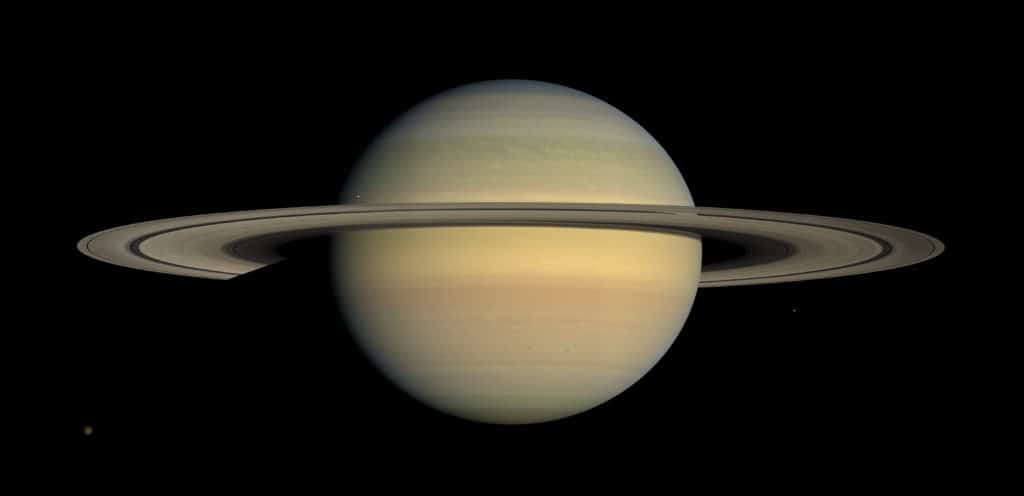
The first telescopic observation was conducted by Galileo Galilei in 1610. Because of the crude telescope available at the time, Galileo failed to observe the rings of Saturn. He thought that the planet was surrounded very closely by two moons but when he looked again, the objects disappeared. After a couple of years, observations made by Christiaan Huygens in 1659, elucidated the mystery, concluding that in fact, the objects were a ring system surrounding Saturn.
Because of the planet’s slow orbit around the sun, it was associated with time, and due to its golden-like glow, it was also associated with wealth. It was thus named after the Roman god of wealth and agriculture Saturn, which is the equivalent of the Greek god of time, Cronos.
Formation
Saturn formed together with the rest of the solar system about 4.5 billion years ago. Gravity pulled swirling gas and dust together and thus the gas giant was created. About 4 billion years ago, Saturn settled into its current position in the outer solar system. Like Jupiter, Saturn is mostly made of hydrogen and helium, the same two main components that make up the Sun.
Distance, Size, and Mass
Saturn is about 9.5 times farther away from the Sun than Earth. At a distance of 9.6 AU away from the Sun and 10.6 AU away from Earth, it is the sixth most distant planet.
Light takes approximately 1 hour and 29 minutes to travel from Saturn and then arrive at Earth. It is the second-largest planet in the Solar System, having a radius of 58.232 km or 36.183 mi, about nine times that of Earth and a diameter of 120.536 km or 74.897 mi, almost 9.5 times bigger than the diameter of Earth.
The surface area is about 83 times bigger than our planet, and the mass of Saturn is about 95 times greater.
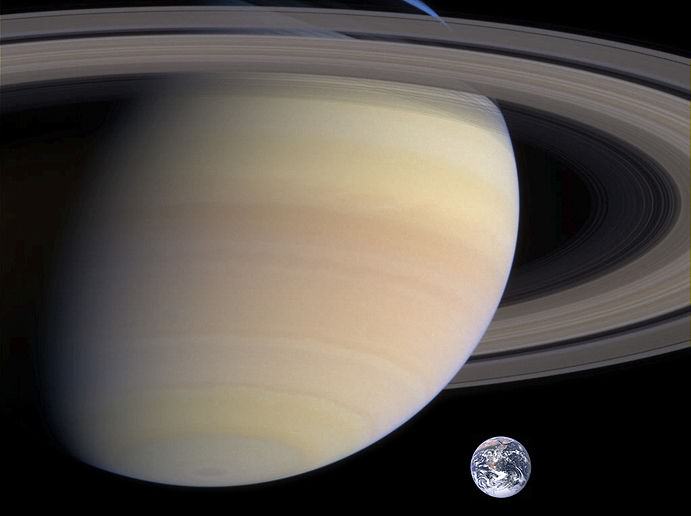
Though the volume of Saturn is about 764 times that of Earth, it is the least dense planet in the solar system. Earth is 8 times denser than Saturn, and if it would have a surface, the gravity would be similar. The density of Saturn has been estimated to be about 0.687 g/cm3, less dense than water due to its gaseous composition.
Orbit and Rotation
Saturn has the second-shortest day in the solar system, completing a rotation quite quickly, in about 10.6 hours. However, its orbit around the Sun is slow, completing one trip around the Sun or a year, in about 29.5 Earth years. Its average orbital speed is about 9.68 km/s - 6.01 mi/s.
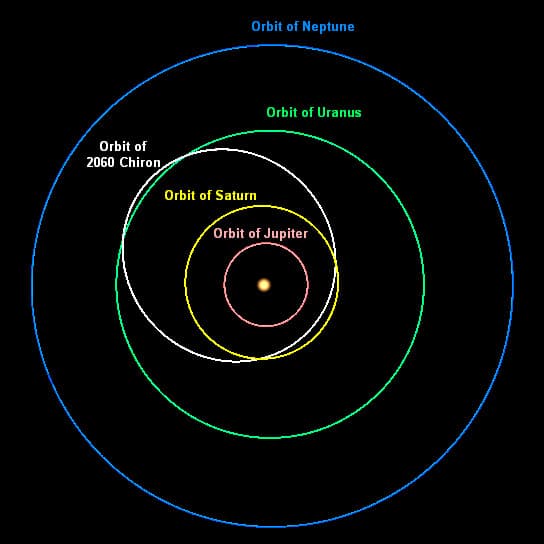
The elliptical orbit of Saturn is inclined 2.48° relative to the orbital plane of the Earth. The perihelion and aphelion distances are, respectively, 9.195 and 9.957 AU, on average.
Axial tilt
Due to Saturn’s axial tilt of 26.73 degrees, similar to that of Earth, the southern and northern hemispheres are heated differently, causing seasonal temperature variations. Much of these variations in temperature are horizontal.
Structure
Predominately composed out of hydrogen and helium, Saturn’s density is the lowest out of all the planets in the Solar System, having no true surface just like Jupiter, Uranus, and Neptune.
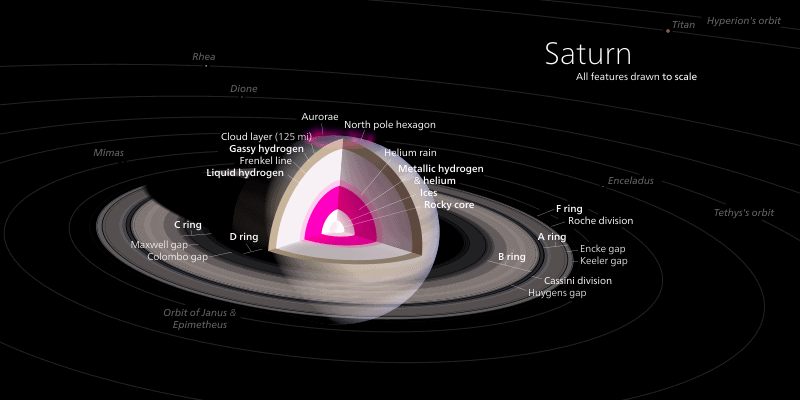
It does have a dense core in the center, composed out of water, ice, and rocky materials, but no actual landmass. The core is believed to be similar to that of Jupiter – rocky, enveloped by a liquid metallic hydrogen layer and a molecular hydrogen layer with traces of various ices.
The interior is very hot at the core – 12.000 K / 11,700 °C – and it radiates 2.5 times the amount of energy it produces into space than it receives from the Sun. It is estimated that the core’s mass is about 9-22 times bigger than that of Earth. This would result in a diameter of 25.000 km/15.534 mi or almost two times the size of Earth.
The thick liquid metallic hydrogen layer followed by a liquid layer of helium-saturated molecular hydrogen gradually transitions to a gas with increasing altitude. The outermost layer spans 1,000 km / 621 mi and consists of gas.
Atmosphere
Covered with clouds that appear as faint stripes, jet streams and storms, Saturn’s upper atmosphere is characterized by winds that can reach up to 1,600 feet / 500 meters per second.
The atmosphere’s pressure is strong enough that it squeezes gas into liquid. The temperature of Saturn’s upper atmosphere is on average about -175C (-285F), quite cold for a gas giant, while below the clouds it gets considerably hotter.
The atmosphere is composed of ammonia, ammonia hydrosulfide, and water that influence the planet's colorful appearance of a brownish-yellow. The outer atmosphere of Saturn contains 96.3% molecular hydrogen and 3.25% helium by volume.
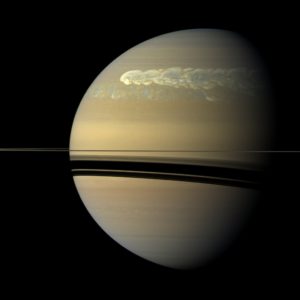
The Great White Spot of Saturn is comprised of many periodic storms large enough to be seen from Earth through a telescope. They are several kilometers wide and encircle the planet, occurring once roughly every Saturnian year - every 30 Earth years. It is predicted that the Great White Spot will occur again in 2020 during the northern hemisphere summer solstice.
Thermography has shown that Saturn's South Pole has a warm polar vortex, the only known example of such a phenomenon in the Solar System. Whereas temperatures on Saturn are normally −185 °C, temperatures on the vortex often reach as high as −122 °C, suspected to be the warmest spot on Saturn.
North Pole Vortex
A persisting hexagonal wave pattern around the north polar vortex in the atmosphere at about 78°N was first noted in the Voyager images. The sides of the hexagon are each about 13,800 km / 8,600 mi long, which is longer than the diameter of Earth.
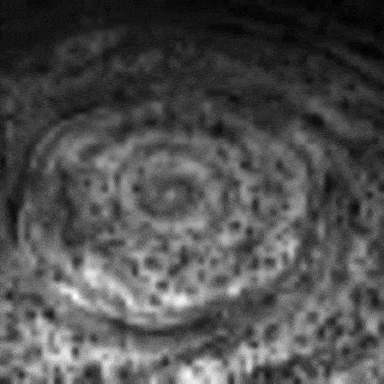
The entire structure rotates with a period of 10 hours-39 minutes - which is the same period as that of the planets eerie radio emissions. This is also assumed to be equal to the period of rotation of Saturn's interior.
South Pole Vortex
The Hubble space telescope imaging of the South Polar Region indicates the presence of a jet stream, however no strong polar vortex nor any hexagonal standing wave.
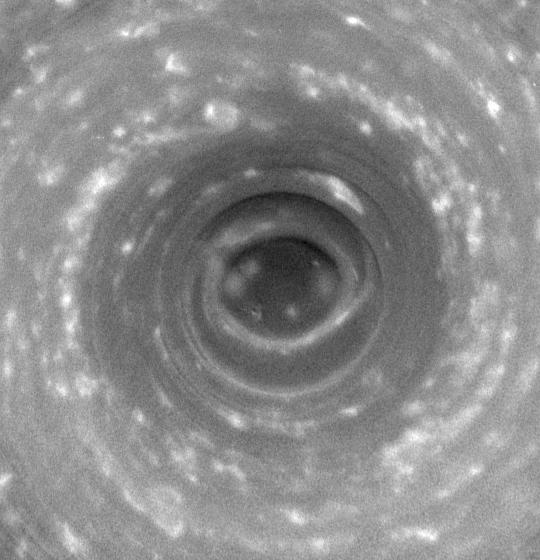
Later the Cassini spacecraft observed a hurricane-like storm locked to the South Pole that had a clearly defined eyewall. Eyewall clouds had not been seen on any other planet except for Earth. It is believed that the South Pole storm may have been present for billions of years. This south vortex is comparable to the size of Earth with winds blowing at speeds of 500/km – 310/mi – per hour.
Magnetosphere
Saturn has an intrinsic magnetic field that has a simple, symmetric shape – a magnetic dipole. Its strength at the equator is about 0.2 gauss / 20 µT – approximately one-twentieth of that of the field around Jupiter. It is slightly weaker than Earth’s magnetic field.
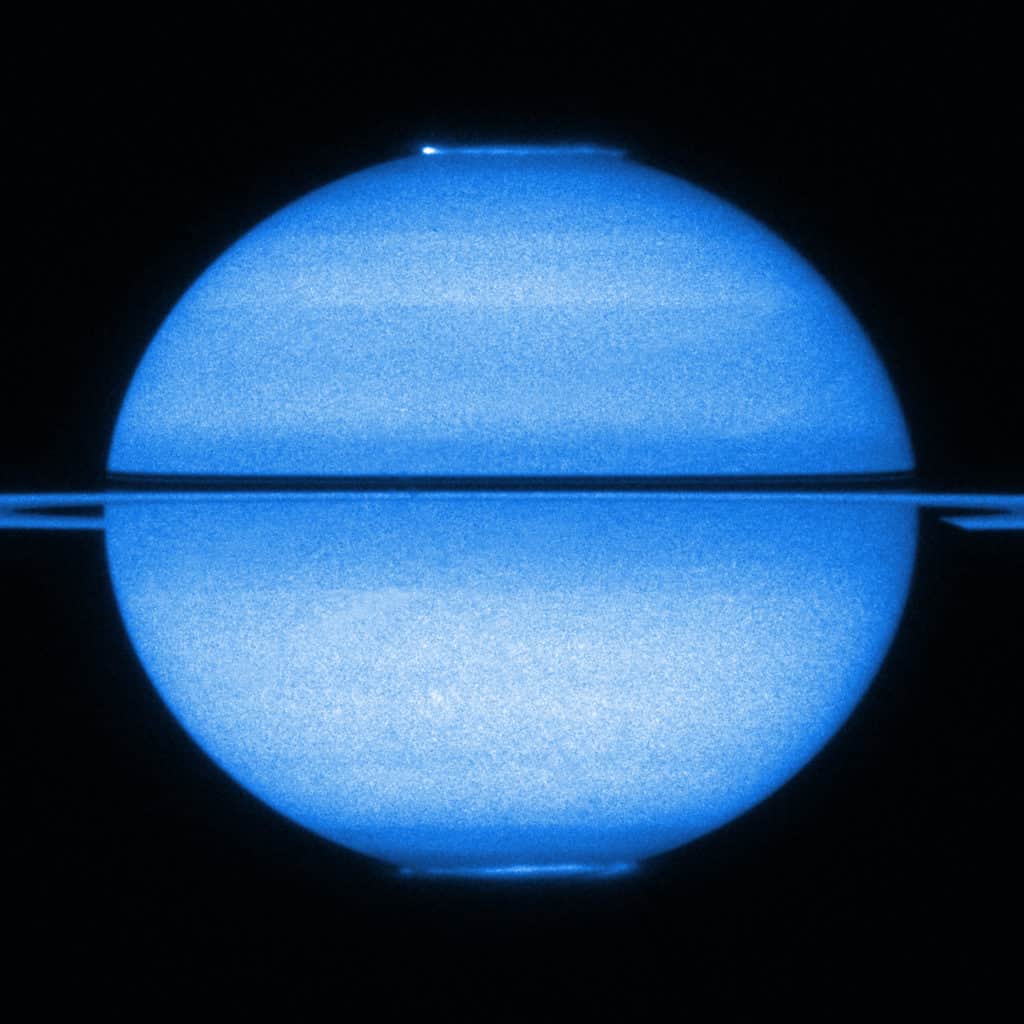
It is believed that Saturn’s magnetic field is generated similarly to that of Jupiter: by currents in the liquid metallic-hydrogen layer called a metallic-hydrogen dynamo. Saturn’s moon Titan orbits within the outer part of the magnetosphere and contributes plasma from the ionized particles in Titan’s outer atmosphere. The magnetosphere also produces aurorae.
Moons
Saturn is now the “king of the moons” in the Solar System, having a total of 82 confirmed and diverse satellites that range from a couple of meters to several hundred kilometers.
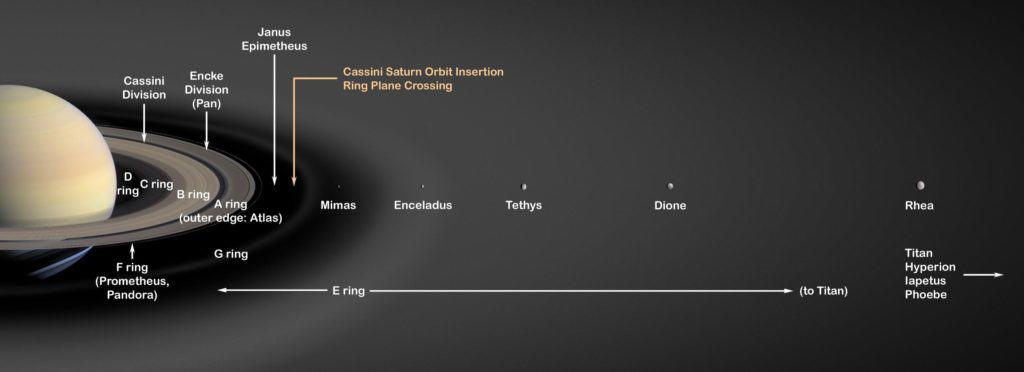
The orbits of these 82 moons have been confirmed as not being embedded in its rings. Only 13 of these satellites have diameters greater than 50 km/31 mi - as well as dense rings that contain millions of embedded moonlets and innumerable smaller ring particles. Only 7 of these moons are large enough to have collapsed into a relaxed, ellipsoidal shape, though only one or two, Titan and possibly Rhea, are currently in hydrostatic equilibrium. Momentarily, not all the moons have been named.
Regular Satellites
Out of the 82 moons, only 24 are regular satellites. This means they have prograde orbits not greatly inclined to Saturn’s equatorial plane. They include the 7 major satellites, 4 small moons that exist in a Trojan orbit with larger moons, 2 mutually co-orbital moons and 2 that act as Sheppard moons of Saturn’s F Ring.
Two other known regular satellites orbit within the gaps of Saturn’s rings, while Hyperion is locked in resonance with Titan, the largest moon of Saturn. The remaining regular moons orbit near the outer edge of the A Ring, within G Ring, and between the major moons Mimas and Enceladus. These regular satellites are usually named after Titans or other figures associated with the mythological Saturn.
Irregular Satellites
Out of the 82 moons, the remaining 58 are irregular moons with diameters ranging from 4 to 213 km – 2.4 to 132 mi. They have orbits much farther from Saturn, high inclinations, and are mixed between prograde and retrograde motions. It is believed that these moons are actually captured minor planets, or debris from the breakup of such bodies after they were captured, creating collisional families.
These irregular satellites have been classified by their orbital characteristics into the Inuit, Norse, and Gallic groups, and their names are chosen from the corresponding mythologies. The largest known irregular moon is Phoebe, the ninth moon of Saturn, discovered at the end of the 19th century.
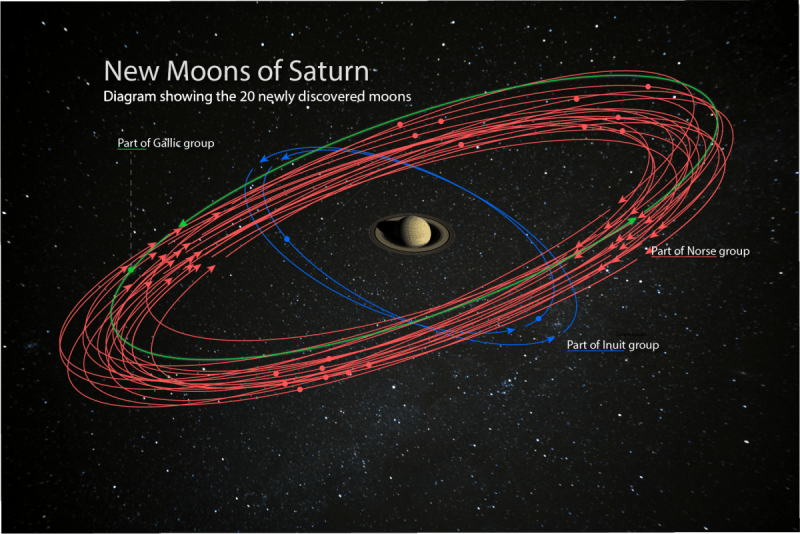
Major Moons
Saturn has seven major satellites with one of them being even bigger than the planet Mercury.
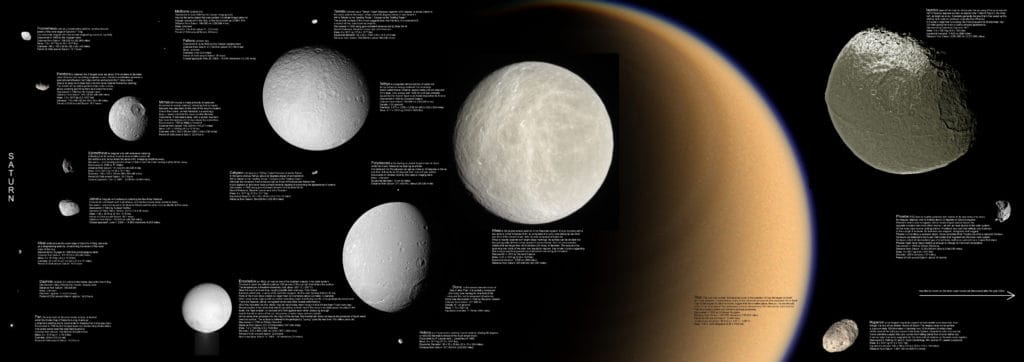
Titan
Titan is the first discovered moon of Saturn. It was discovered in 1655 by astronomer Christiaan Huygens. It is the largest moon of Saturn and the second-biggest moon in the Solar System.
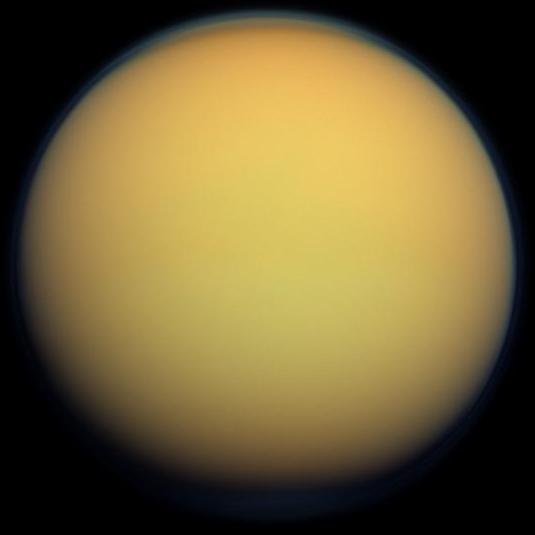
It has a radius of about 1.600 mi / 2.575 km and a diameter of 3.199 mi / 5.149 km. It is bigger in size than the planet Mercury but only 40% as massive. Titan is 50% larger than Earth’s moon and 80% more massive. It is almost as wide as the state of Canada.
Though it is second in size only to Jupiter’s moon Ganymede, Titan is the only moon in the Solar System with clouds and a dense atmosphere with clear evidence of stable bodies of surface liquid.
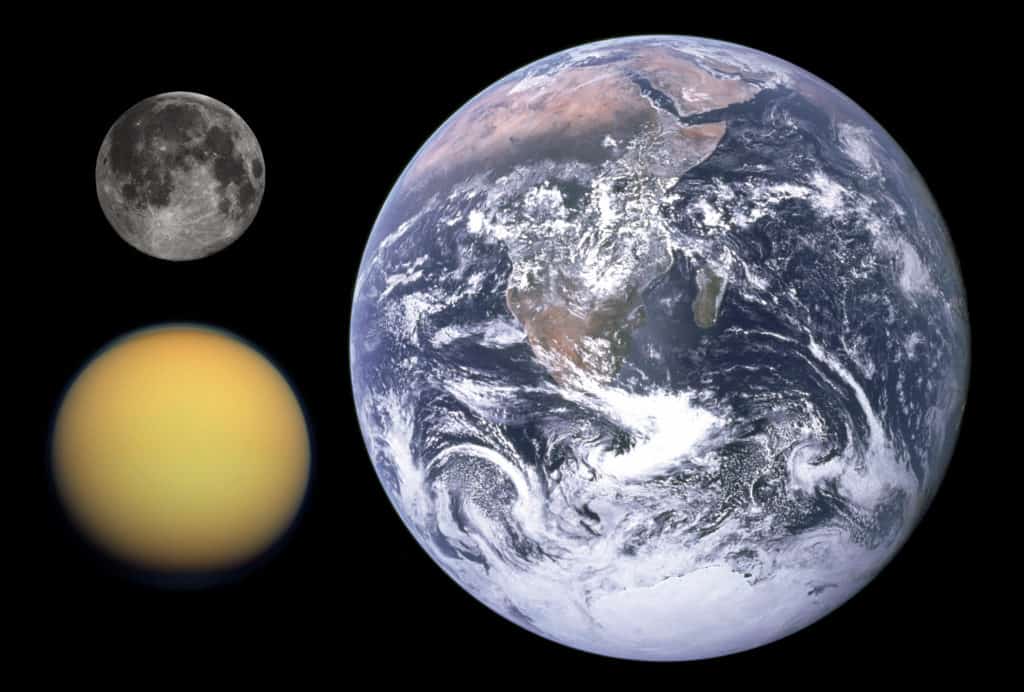
The moon is primarily composed of ice and rocky material, with a rocky core in the center surrounded by various layers of ice, and a subsurface layer of ammonia-rich liquid water. The atmosphere is largely made up of nitrogen, methane, and ethane clouds with nitrogen-rich organic smog. Climate features include wind and rain that create features similar to those of Earth, such as dunes, rivers, lakes, seas, and deltas.
It orbits Saturn once every 15 days and 22 hours and it is tidally locked with its parent planet, only one side of its face is director towards Saturn, permanently. The small, irregularly shaped satellite Hyperion is locked in a 3:4 orbital resonance with Titan.
Analysis of Titan's atmospheric nitrogen suggested that it has possibly been sourced from a material similar to that found in the Oort cloud and not from sources present during co-accretion of materials around Saturn.
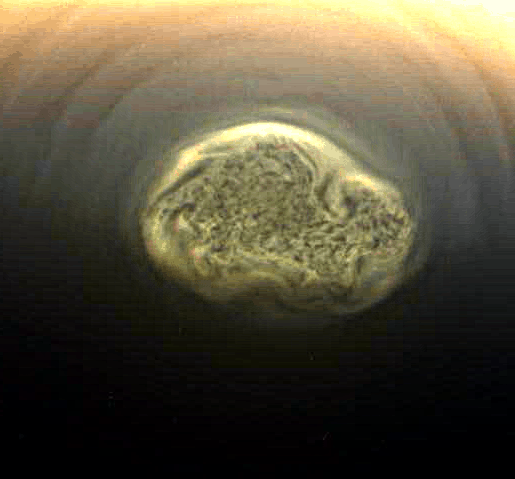
The surface temperature is about 94 K (−179.2 °C). At this temperature, water ice has an extremely low vapor pressure, so the little water vapor present appears limited to the stratosphere. Titan receives about 1% as much sunlight as Earth. Atmospheric methane creates a greenhouse effect on Titan's surface, without which Titan would be far colder.
Titan is the most distant body from Earth to have a space probe land on its surface. The spacecraft Huygens landed on Titan in 2005. Analysis since then points out that Titan may be a prebiotic environment rich in complex organic compounds. It contains a global ocean beneath its icy shell, and within this ocean, conditions are potentially suitable for microbial life. These discoveries make Titan a very closely studied object, with future missions already being planned.
Hyperion
It is the first non-round moon to be discovered in the Solar System. It was discovered in 1848 by William Bond, George Bond, and William Lassell. Its irregular shape, chaotic rotation, and sponge-like appearance make it a very unique object.
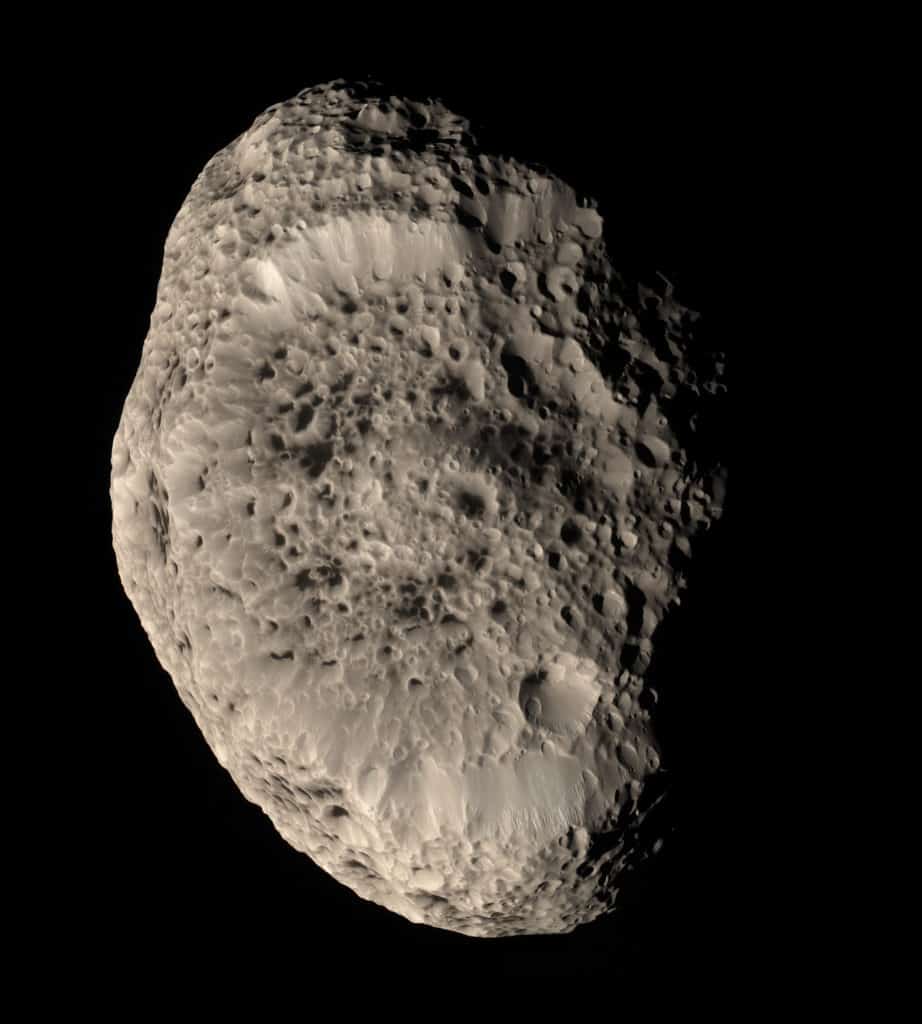
It is named after the Titan god of watchfulness and observation, the elder brother of Cronus. Hyperion has a diameter of about 121.57 km/ 75.54 mi, making it one of the largest known bodies of highly irregular shape in the Solar System. It is believed that this moon was once part of a larger body that suffered a large impact in the past.
Like most of the other moons, it has a low density suggesting that it is composed largely out of water ice and rock. The surface is covered with deep, sharp-edged craters that give it an appearance similar to that of a sponge. Dark material fills the bottom of each crater. Its rotation is chaotic, wobbling so much that its orientation in space is quite unpredictable. Together with Pluto’s moons Nix and Hydra, they are among the few moons in the Solar System that rotate chaotically.
Enceladus
Enceladus is the sixth-largest moon of Saturn with a diameter of around 500 km / 310 mi. It was discovered in 1789 by William Herschel and named after the giant Enceladus of Greek mythology.
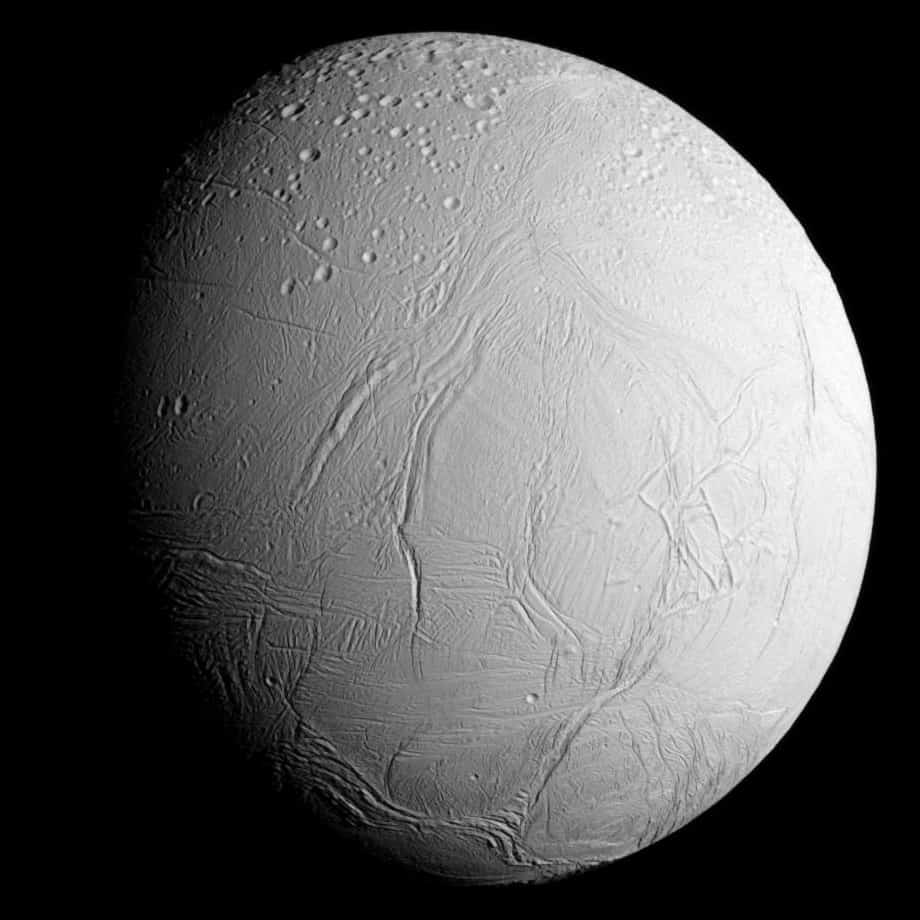
This moon is mostly covered by fresh, clean ice, making it one of the most reflective bodies of the Solar System. The surface temperature at noon reaches 198 °C (−324 °F), far colder than a light-absorbing body would be.
Over 100 geysers have been identified, together with water-rich plumes, cryovolcanoes that shoot geyser-like jets of water vapor, molecular hydrogen, other volatiles, and solid material into space. Some of the water vapor falls back unto its surface creating fresh snow, while the rest supplies most of the material that makes up Saturn’s E Ring system.
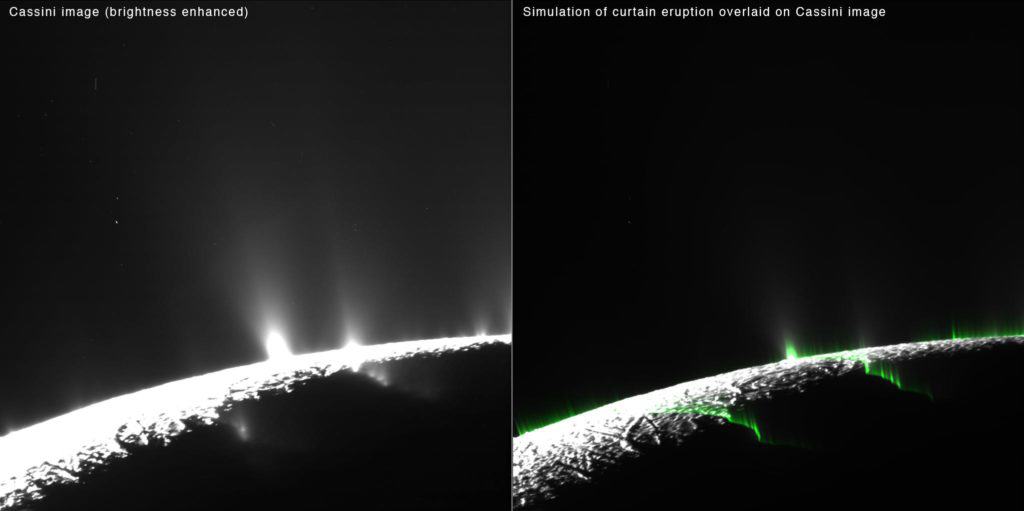
It is the only moon of Saturn that is currently endogenously active while at the same time, it is the smallest known body in the Solar System that is geologically active today.
Enceladus releases gas and dust at a rate of more than 100 kg/s. It may also have liquid water underneath its south-polar surface. The energy source for Enceladus’s cryovolcanism is thought to be its 2:1 mean-motion resonance with Dione, the second-largest inner moon of Saturn.
Recently, data revealed the presence of organic compounds in the plumes of liquid water that shoot into space. These compounds carry nitrogen and oxygen – elements that play a key role in producing amino acids, the building blocks of proteins.
Tethys
Tethys is the third-largest inner moon of Saturn. It has the lowest density out of all the moons suggesting it is primarily made out of water, and a small fraction of rock. It was discovered in 1684 by G.D. Cassini and named after a titan of Greek mythology.
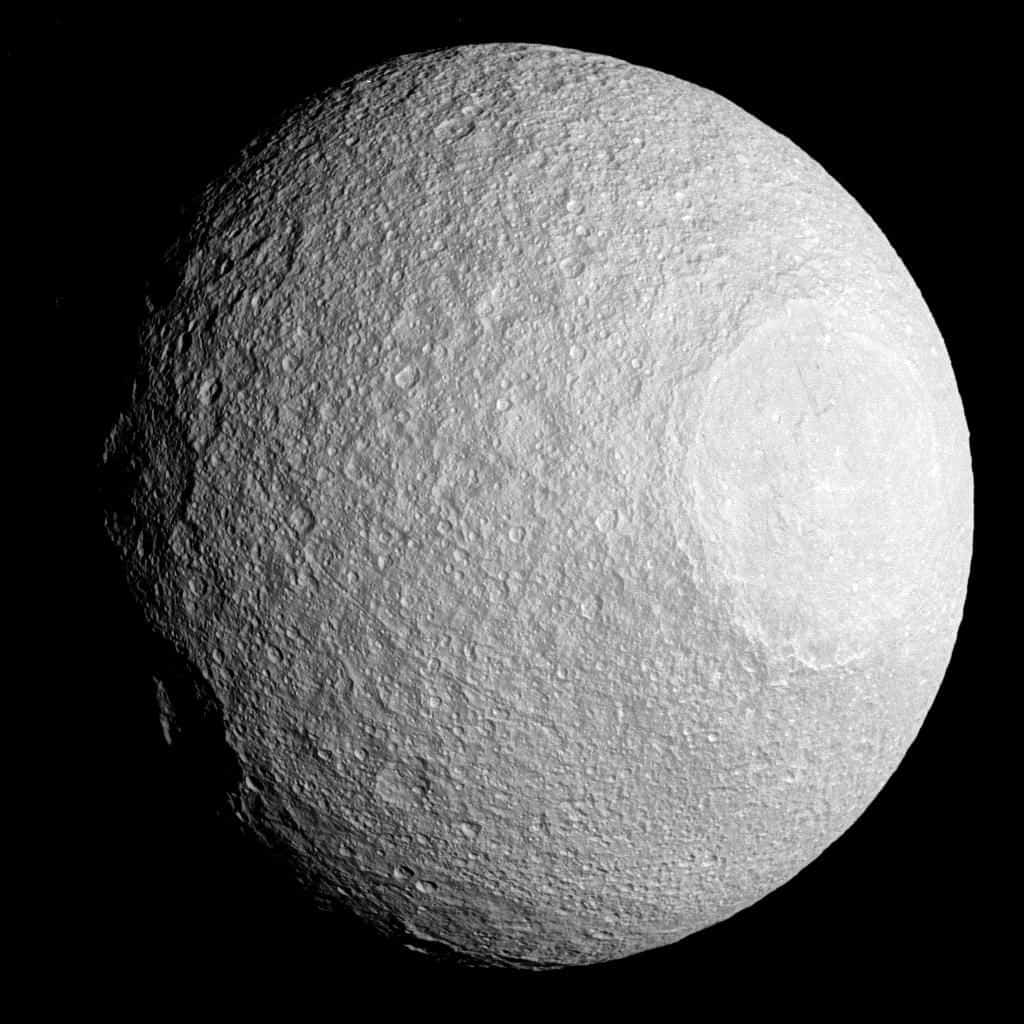
It has a diameter of about 1.060 km / 660 mi and a low density of 0.98 g/cm3. A small amount of unidentified dark material is present on the moon. It is the second-brightest moon of Saturn and it is heavily cratered and cut by large faults/graben. A famous crater is named Odysseus, having a diameter of 400 km / 248 mi. It is believed that the moon formed alongside the other regular moons from the Saturnian sub-nebula – a disk of gas and dust that surrounded Saturn soon after its formation. It orbits Saturn at a distance of almost 295.000 km / 183.304 mi.
Dione
Dione is the second-largest inner moon of Saturn. It has a higher density than the geologically dead Rhea, the largest inner moon, but lower than that of active Enceladus.
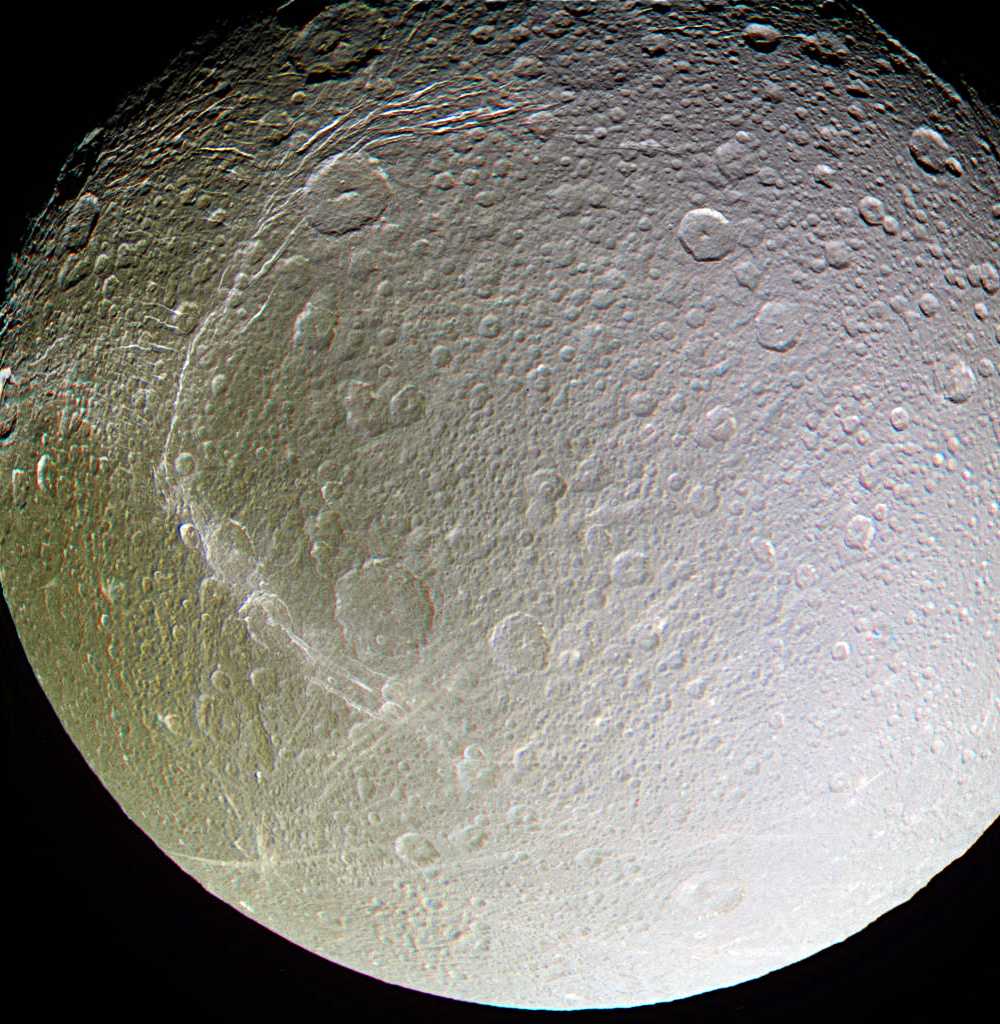
It was discovered in 1684 by G.D. Cassini and named after a titan of Greek mythology. It orbits Saturn with a semimajor axis and it is currently in a 1:2 mean-motion orbital resonance with moon Enceladus, completing one orbit of Saturn for every two orbits completed by Enceladus.
This resonance maintains Enceladus's orbital eccentricity (0.0047), providing a source of heat for Enceladus's extensive geological activity, which shows up most dramatically in its cryovolcanic geyser-like jets. Dione has a diameter of about 1.122 km / 697 mi, being the 15th largest moon in the Solar System while its mass is greater than all the other small moons combined.
About two-thirds of Dione's mass is water ice, and the remaining is a dense core, probably silicate rock. Further information suggests that it also has an internal liquid saltwater ocean similar to Enceladus.
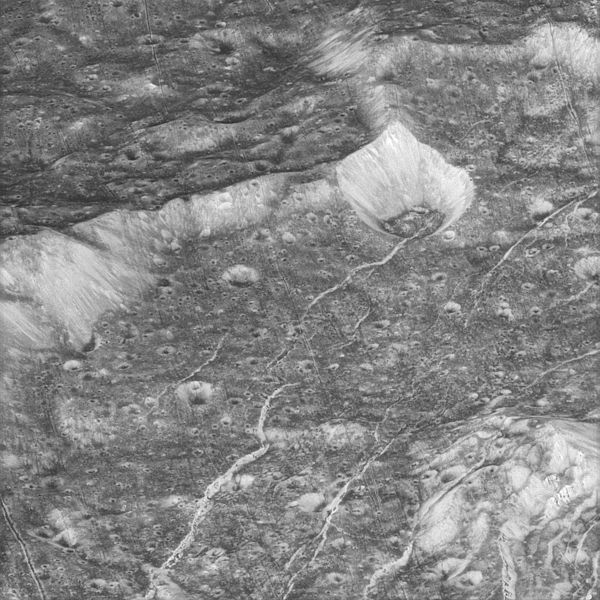
While the majority of Dione's surface is heavily cratered old terrain, the moon is also covered with an extensive network of troughs and lineaments, indicating that in the past it had global tectonic activity. Dione may be geologically active even now, although on a scale much smaller than the cryovolcanism of Enceladus.
Rhea
Named after the “mother of the gods” in Greek mythology, Rhea was discovered in 1672 by G.D Cassini. It is the second-largest moon of Saturn and the ninth-largest in the Solar System.
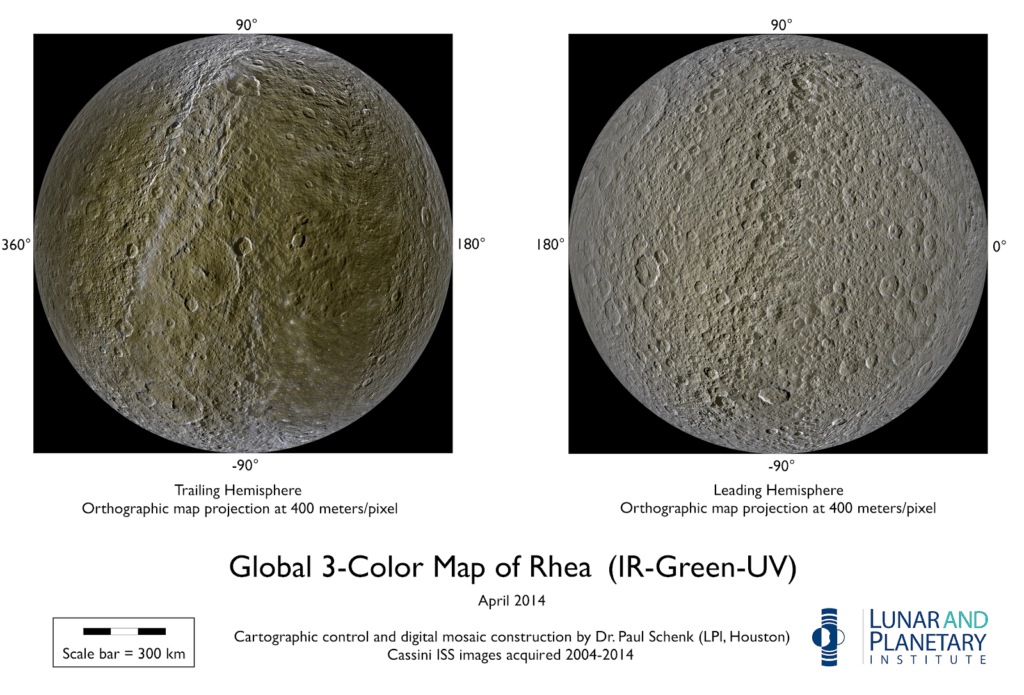
It has a density of about 1.236 g/cm3. This low density indicates that it is made of ~25% rock (density ~3.25 g/cm3) and ~75% water ice (density ~0.93 g/cm3). Although Rhea is the ninth-largest moon, it is only the tenth-most-massive moon. Rhea's features resemble those of Dione, with dissimilar leading and trailing hemispheres, suggesting similar composition and histories. The temperature on Rhea is 99 K (−174 °C) in direct sunlight and between 73 K (−200 °C) and 53 K (−220 °C) in the shade.
Rhea has a diameter of about 1.528 km / 949 mi and a tenuous atmosphere – exosphere - that consists of oxygen and carbon dioxide. It is possible that Rhea may have a tenuous ring system as well, meaning it would be the first moon with rings ever discovered but observations continue.
Iapetus
The third-largest moon of Saturn, Iapetus orbits its planet parent at a distance of 3.5 million km / 2.1 million mi, by far the most distant of Saturn’s large moons, and also it has the largest orbital inclination, 15.47°.
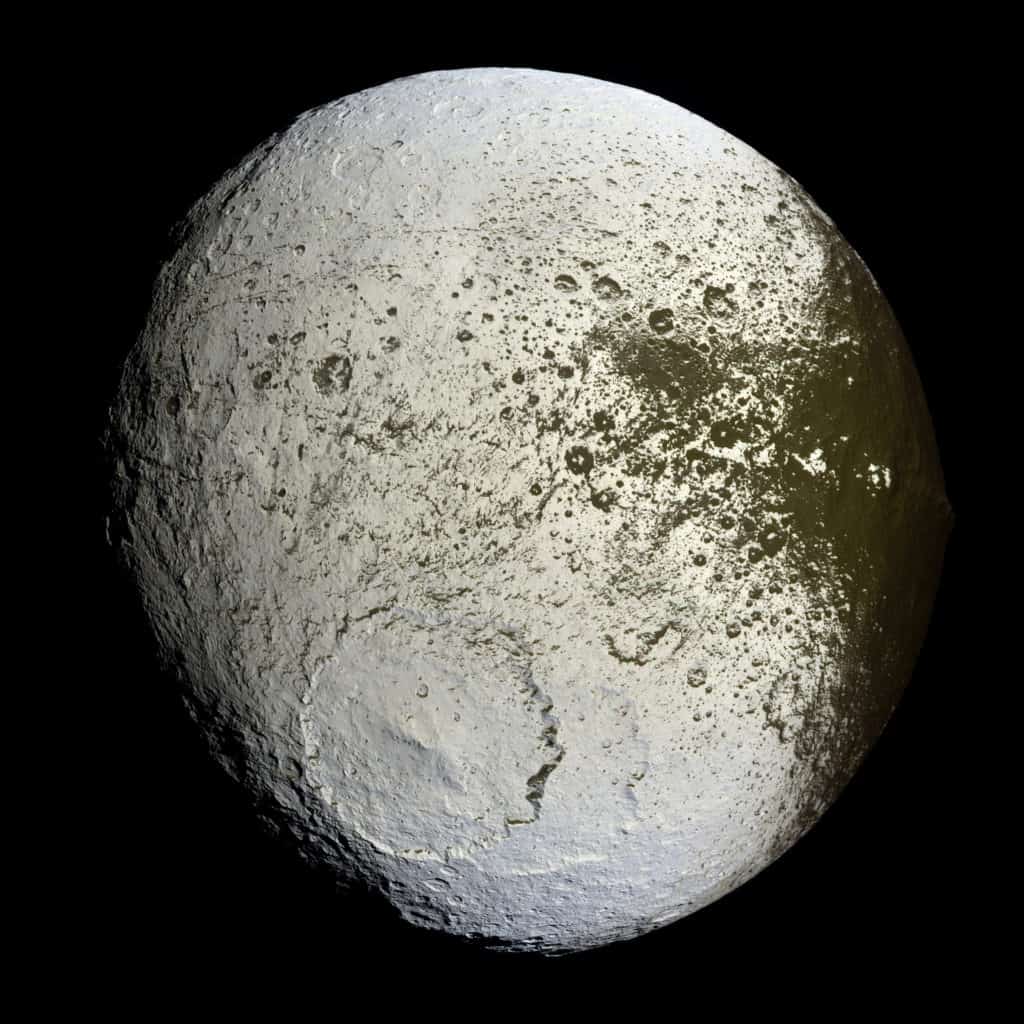
Known for its unusual two-toned surface, it was discovered in 1671 by G.D. Cassini and named after a titan of Greek mythology. It is tidally locked, always keeping the same face towards Saturn and has a diameter of about 1.436 km / 892 mi. Due to its appearance, it is nicknamed the yin-yang of the solar system.
It also has a low density, indicating that it is mostly comprised of ice and rocky materials. It’s neither spherical nor ellipsoid but has a bulging waistline and squashed poles. This unique equatorial ridge is so high that it can be viewed from a distance. The equatorial ridge runs along the center of Cassini Regio, about 1,300 km (810 mi) long, 20 km (12 mi) wide, and 13 km (8.1 mi) high.
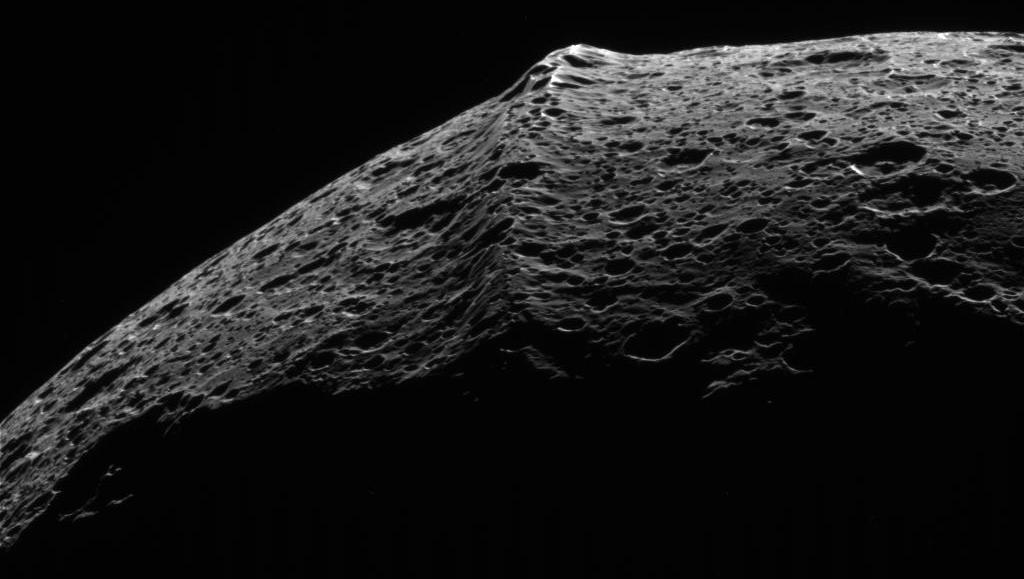
It is not well understood neither how this ridge was created nor why Iapetus has such a chaotic orbit, but generally, it is believed that collisions are at fault. The two-tone coloration is often attributed to Phoebe, a smaller moon that orbits Saturn. Phoebe is very dark and emits streams of particles due to the Sun’s radiation and minor collisions.
These particles accumulate on one side of Iapetus while the other remains white due to differences in temperature.
Planetary Rings
The moons of Saturn also play a role in the planet's ring system. The ring system of Saturn is the largest and most complex in the entire Solar System. They are made out of ice and rock remnants from comets, asteroids, and moons.
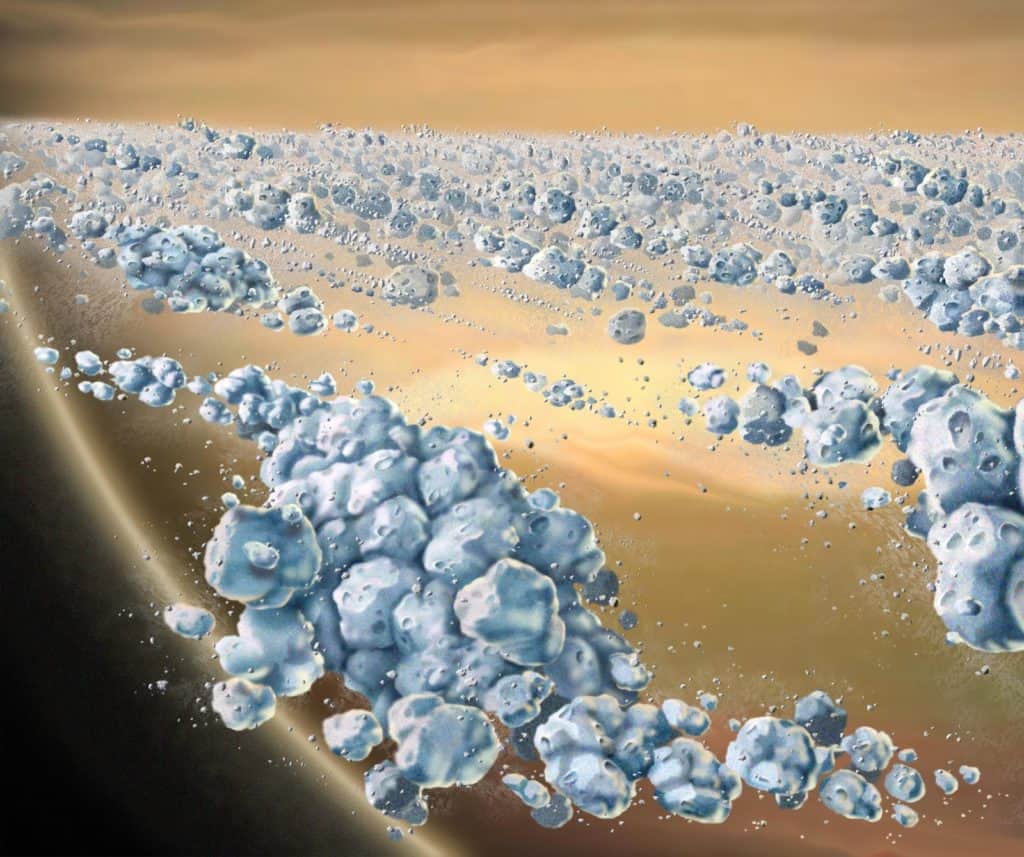
These particles range in size from being as small as dust to as big as houses, or even mountains. The ring system is divided into 7 groups of rings: D Ring, C Ring, B Ring, A Ring, F Ring, G Ring, and E Ring.
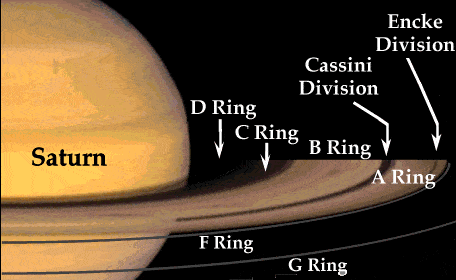
Together, they are as wide as 4.5 Earths but only about two-thirds of a mile thick. The rings can extend up to 282.000 km / 175.000 mi from the planet. They stay intact and on track because of Saturn’s smallest moons. These shepherding moons orbit between the rings and use their gravity to shape the ring material into circular paths.
Life Habitability
Since it doesn’t have a true surface, but rather swirling fluids, it is not conducive to life as we know it. The moons of Saturn however, respectively Titan and Enceladus, have internal oceans that could possibly hold life.
Future plans for Saturn
Much of Saturn has been discovered, and much still remains to be discovered. Right now, since its moons, Titan and Enceladus, have higher chances of either containing life or being somewhat more hospitable than Saturn and the rest of its moons, most our attention is directed towards them. The conditions on Titan could become far more habitable in the far future, as such a mission named Dragonfly will launch in 2026, consisting of a large drone powered by an RTG, to fly in the atmosphere of Titan.
The purpose of this mission is to study how far prebiotic chemistry may have progressed. It is possible that Enceladus may also be subject to further observations.
Did you know?
- Saturn has the eeriest radio emissions in the Solar System. The planet’s sounds can be found and listened to, on the internet.
- It is estimated that Saturn will lose its rings in about 100 million years. The rings are being pulled into Saturn by gravity as a dusty rain of ice particles under the influence of Saturn’s magnetic field. This event is often called Ring Rain.
- The closest distance of Saturn to Earth will happen in 2091, at a distance of 8.03 AU.
- You could fit 764 Earths inside Saturn, and almost 1.600 Saturn’s could fit into the Sun.
- A theory suggests that Saturn and Jupiter came close to one another and thus provoked the “Great Flood” on Earth.
- Controversially, recent studies of ancient cultures show that the ancients might have mistakenly considered Saturn as the Sun or at least, a Sun-like object. Some cultures considered that Saturn was a star.
- The day Saturday was named after Saturn.
- The winds on Saturn are the second fastest among the Solar System's planets, after Neptune's.
- The mean apparent magnitude of Saturn is 0.46 with a standard deviation of 0.34. Most of the magnitude variation is due to the inclination of the ring system relative to the Sun and Earth. The brightest magnitude, −0.55, occurs near in time to when the plane of the rings is inclined most highly, and the faintest magnitude, 1.17, occurs around the time when they are least inclined.
- Twice every Saturnian year - roughly every 15 Earth years - the rings of Saturn briefly disappear from view, due to the way in which they are angled and because they are thin. Such an event will next occur in 2025, but Saturn will be too close to the Sun for any ring-crossing observation to be possible.
- As Saturn is now the new king of the moons, with 20 new moons being discovered, a contest is held online for the naming of these moons. The contest ends on December 6, 2019 – so we recommend you to search for this on the internet if you are interested in providing a name.
- Saturn’s largest moon Titan comprises more than 96% of the mass in orbit around the planet.
- Scientists surmise that the atmosphere of early Earth was similar in composition to the current atmosphere on Titan, with the important exception of a lack of water vapor on Titan.
- In ancient Greek, Saturn was known as Phainon while in Hindu astrology, it was known as Shani, a deity that judges everyone based on the good and bad deeds performed in life.
- Ancient Chinese and Japanese cultures designated Saturn as the “earth star”.
- Almost two tons of Saturn’s mass came from Earth – The Cassini spacecraft was intentionally vaporized in Saturn’s atmosphere in 2017.
- Only four spacecraft’s have visited Saturn: NASA’S Pioneer 11 in 1979, NASA’S twin Voyager 1 & 2 in 1980 and 1981, and the international Cassini spacecraft mission in 2004.
- The spacecraft Cassini studied Saturn for about 13 years.
Sources:
Image source:
- https://upload.wikimedia.org/wikipedia/commons/c/c7/Saturn_during_Equinox.jpg
- https://www.universetoday.com/24161/saturn-compared-to-earth/
- https://scitechdaily.com/chiron-may-possess-saturn-like-rings/
- https://upload.wikimedia.org/wikipedia/commons/2/2d/Saturn_diagram.svg
- https://upload.wikimedia.org/wikipedia/commons/2/29/Saturn_Storm.jpg
- https://upload.wikimedia.org/wikipedia/commons/b/bd/Rotatingsaturnhexagon.gif
- https://upload.wikimedia.org/wikipedia/commons/5/57/Looking_saturn_in_the_eye.jpg
- https://upload.wikimedia.org/wikipedia/commons/b/b1/Saturn%27s_double_aurorae_%28captured_by_the_Hubble_Space_Telescope%29.jpg
- https://upload.wikimedia.org/wikipedia/commons/f/f7/Saturn%27s_Rings_PIA03550.jpg
- https://carnegiescience.edu/NameSaturnsMoons
- https://upload.wikimedia.org/wikipedia/commons/4/4b/Moons_of_Saturn_2007.jpg
- https://upload.wikimedia.org/wikipedia/commons/4/45/Titan_in_true_color.jpg
- https://upload.wikimedia.org/wikipedia/commons/b/b4/Titan%2C_Earth_%26_Moon_size_comparison.jpg
- https://upload.wikimedia.org/wikipedia/commons/d/da/Vortex_on_saturn%27s_moon_titan.png
- https://upload.wikimedia.org/wikipedia/commons/9/94/Hyperion_true.jpg
- https://upload.wikimedia.org/wikipedia/commons/8/83/PIA17202_-_Approaching_Enceladus.jpg
- https://upload.wikimedia.org/wikipedia/commons/7/72/PIA19061-SaturnMoonEnceladus-CurtainNotDiscrete-Eruptions-20150506.jpg
- https://upload.wikimedia.org/wikipedia/commons/b/bc/PIA18317-SaturnMoon-Tethys-Cassini-20150411.jpg
- https://upload.wikimedia.org/wikipedia/commons/c/c7/Dione_color.jpg
- https://en.wikipedia.org/wiki/File:Dione_PIA07748_-Amastrus_grooves.jpg
- https://upload.wikimedia.org/wikipedia/commons/f/f5/PIA18438-SaturnMoon-Rhea-20141104-fig2.jpg
- https://upload.wikimedia.org/wikipedia/commons/c/c9/Iapetus_as_seen_by_the_Cassini_probe_-_20071008.jpg
- https://upload.wikimedia.org/wikipedia/commons/b/b4/Iapetus_equatorial_ridge.jpg
- https://upload.wikimedia.org/wikipedia/commons/d/de/Saturn_Ring_Material.jpghttp://www.solstation.com/stars/sat1ring.gif
